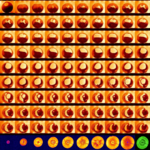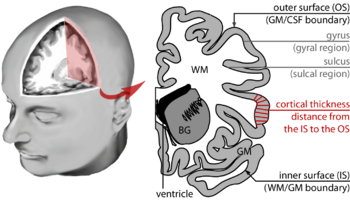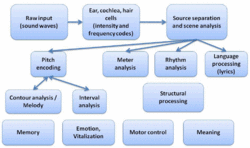User:Daniel Mietchen: Difference between revisions
imported>Daniel Mietchen (__TOC__) |
John Leach (talk | contribs) m (Text replacement - "Magnetic Resonance Imaging" to "Magnetic resonance imaging") |
||
| (7 intermediate revisions by 4 users not shown) | |||
| Line 1: | Line 1: | ||
{{AccountNotLive}} | |||
[[Image:Magnetic resonance microscopy montage embryo fossil.png|right|150px]] | [[Image:Magnetic resonance microscopy montage embryo fossil.png|right|150px]] | ||
{{TOC|left}} | |||
==Background== | |||
I am a [[biophysicist]] focusing on the application of methods from [[physics]] to the study of [[morphology (biology)|biological structures]] and processes from a comparative [[evolution]]ary perspective, with a current emphasis on applications of [[brain morphometry]] (e.g. [[gyrification]] and [[cortical thickness]]) to the study of [[schizophrenia]]. | |||
Other than that, I am actively involved in the emerging field of [[Science 2.0]], in which [[Web 2.0]] tools like [[wiki]]s or [[blog]]s are combined with the [[scientific method]], typically to make the [[:Image:Research cycle.png|research process]] or its results more widely and more rapidly [[open science|accessible]] as well as more [http://ways.org/en/blogs/2009/nov/29/what_if_science_were_sustainable sustainable]. I have a special interest in [http://www.science3point0.com/coaspedia/ integrating wikis with expert workflows] and [http://meta.wikimedia.org/wiki/Research_Committee vice] [[Open Knowledge Conference/Program/Collaborative Structuring of Knowledge by Experts and the Public|versa]]. I am an occasional contributor to [http://toolserver.org/~vvv/sulutil.php?user=Mietchen Wikipedias and related projects], particularly in areas or languages not covered here yet, as well as to [[Encyclopedia of Earth]], [[Scholarpedia]] and [[WikiEducator]]. More information about me can be found [http://www.google.com/profiles/daniel.mietchen here]. | |||
At Citizendium, I am the elected [[CZ:Managing Editor|Managing Editor]], tasked with deciding on matters for which no clear applicable policy exists. Thematically, my contributions focus on the above-mentioned topics (detailed listing [[User:Daniel Mietchen/Topics|here]]), and I also contribute to [[CZ:Eduzendium]] (e.g. [[CZ:Guidel 2008 summer course on Music and Brain|this summer school]]). | |||
<br /> | <br /> | ||
| Line 35: | Line 38: | ||
| author = Mietchen, D., Manz, B., Volke, F., Storey, K. B. | | author = Mietchen, D., Manz, B., Volke, F., Storey, K. B. | ||
| year = 2008 | | year = 2008 | ||
| title = In Vivo Assessment of Cold Adaptation in Insect Larvae by Magnetic | | title = In Vivo Assessment of Cold Adaptation in Insect Larvae by Magnetic resonance imaging and Magnetic Resonance Spectroscopy | ||
| journal = PLoS ONE | | journal = PLoS ONE | ||
| volume = 3 | | volume = 3 | ||
| Line 46: | Line 49: | ||
! style="background-color: #f2dfce;" | Video supplement | ! style="background-color: #f2dfce;" | Video supplement | ||
|- | |- | ||
|{{#ev:vimeo|4964033| | |{{#ev:vimeo|4964033|300}} | ||
{{#ev:vimeo|4964093| | {{#ev:vimeo|4964093|300}} | ||
{{#ev:vimeo|4964133| | {{#ev:vimeo|4964133|300}} | ||
{{#ev:vimeo|4964219| | {{#ev:vimeo|4964219|300}} | ||
{{#ev:vimeo|4964279| | {{#ev:vimeo|4964279|300}} | ||
{{#ev:vimeo|4964330| | {{#ev:vimeo|4964330|300}} | ||
{{#ev:vimeo|4964531| | {{#ev:vimeo|4964531|300}} | ||
{{#ev:vimeo|4964391| | {{#ev:vimeo|4964391|300}} | ||
{{#ev:vimeo|4964427| | {{#ev:vimeo|4964427|300}} | ||
{{#ev:vimeo|4560767| | {{#ev:vimeo|4560767|300}} | ||
{{#ev:vimeo|4560953| | {{#ev:vimeo|4560953|300}} | ||
|} | |} | ||
| Line 62: | Line 65: | ||
| author = Mietchen, D.; Aberhan, M.; Manz, B.; Hampe, O.; Mohr, B.; Neumann, C.; Volke, F. | | author = Mietchen, D.; Aberhan, M.; Manz, B.; Hampe, O.; Mohr, B.; Neumann, C.; Volke, F. | ||
| year = 2008 | | year = 2008 | ||
| title = Three-dimensional Magnetic | | title = Three-dimensional Magnetic resonance imaging of fossils across taxa | ||
| journal = Biogeosciences | | journal = Biogeosciences | ||
| volume = 5 | | volume = 5 | ||
| Line 72: | Line 75: | ||
! style="background-color: #f2dfce;" | Video supplement | ! style="background-color: #f2dfce;" | Video supplement | ||
|- | |- | ||
|{{#ev:vimeo|5027279| | |{{#ev:vimeo|5027279|300}} | ||
{{#ev:vimeo|5027286| | {{#ev:vimeo|5027286|300}} | ||
{{#ev:vimeo|5027287| | {{#ev:vimeo|5027287|300}} | ||
{{#ev:vimeo|5027288| | {{#ev:vimeo|5027288|300}} | ||
{{#ev:vimeo|5027290| | {{#ev:vimeo|5027290|300}} | ||
|} | |} | ||
| Line 116: | Line 119: | ||
! style="background-color: #f2dfce;" | Video supplement | ! style="background-color: #f2dfce;" | Video supplement | ||
|- | |- | ||
|{{#ev:vimeo|4963736| | |{{#ev:vimeo|4963736|300}} | ||
{{#ev:vimeo|4963816| | {{#ev:vimeo|4963816|300}} | ||
{{#ev:vimeo|4963838| | {{#ev:vimeo|4963838|300}} | ||
{{#ev:vimeo|4963886| | {{#ev:vimeo|4963886|300}} | ||
|} | |} | ||
| Line 148: | Line 151: | ||
| author = Mietchen, D.; Keupp, H.; Manz, B.; Volke, F. | | author = Mietchen, D.; Keupp, H.; Manz, B.; Volke, F. | ||
| journal = Biogeosciences | | journal = Biogeosciences | ||
| title = Non-invasive diagnostics in fossils – Magnetic | | title = Non-invasive diagnostics in fossils – Magnetic resonance imaging of pathological belemnites | ||
| volume = 2 | | volume = 2 | ||
| pages = 133-140 | | pages = 133-140 | ||
| Line 157: | Line 160: | ||
! style="background-color: #f2dfce;" | Video supplement | ! style="background-color: #f2dfce;" | Video supplement | ||
|- | |- | ||
|{{#ev:vimeo|5026838| | |{{#ev:vimeo|5026838|300}} | ||
{{#ev:vimeo|5026939| | {{#ev:vimeo|5026939|300}} | ||
{{#ev:vimeo|5027060| | {{#ev:vimeo|5027060|300}} | ||
{{#ev:vimeo|5027100| | {{#ev:vimeo|5027100|300}} | ||
{{#ev:vimeo|5027102| | {{#ev:vimeo|5027102|300}} | ||
|} | |} | ||
| Line 192: | Line 195: | ||
[[Category:CZ Authors]] | [[Category:CZ Authors]] | ||
[[Category:CZ Editors]] | [[Category:Inactive CZ Editors]] | ||
[[Category:Biology Authors]] | [[Category:Biology Authors]] | ||
[[Category:Biology Editors]] | [[Category:Inactive Biology Editors]] | ||
[[Category:Physics Authors]] | [[Category:Physics Authors]] | ||
[[Category:Physics Editors]] | [[Category:Inactive Physics Editors]] | ||
[[Category:Psychology Authors]] | [[Category:Psychology Authors]] | ||
[[Category:Psychology Editors]] | [[Category:Inactive Psychology Editors]] | ||
[[Category:CZ Charter Drafting Committee Members|Mietchen, Daniel]] | |||
[[Category:CZ Managing Editors]] | |||
[[Category:Eduzendium Educators]] | [[Category:Eduzendium Educators]] | ||
Latest revision as of 03:54, 21 March 2024
The account of this former contributor was not re-activated after the server upgrade of March 2022.
Background
I am a biophysicist focusing on the application of methods from physics to the study of biological structures and processes from a comparative evolutionary perspective, with a current emphasis on applications of brain morphometry (e.g. gyrification and cortical thickness) to the study of schizophrenia.
Other than that, I am actively involved in the emerging field of Science 2.0, in which Web 2.0 tools like wikis or blogs are combined with the scientific method, typically to make the research process or its results more widely and more rapidly accessible as well as more sustainable. I have a special interest in integrating wikis with expert workflows and vice versa. I am an occasional contributor to Wikipedias and related projects, particularly in areas or languages not covered here yet, as well as to Encyclopedia of Earth, Scholarpedia and WikiEducator. More information about me can be found here.
At Citizendium, I am the elected Managing Editor, tasked with deciding on matters for which no clear applicable policy exists. Thematically, my contributions focus on the above-mentioned topics (detailed listing here), and I also contribute to CZ:Eduzendium (e.g. this summer school).
Research areas
Text in this section is transcluded from the respective Citizendium entries and may change when these are edited.
Brain morphometry is a subfield of both morphometry and the brain sciences, concerned with the measurement of brain structures and changes thereof during development, aging, learning, disease and evolution. Since autopsy-like dissection is generally impossible on living brains, brain morphometry starts with noninvasive neuroimaging data, typically obtained from magnetic resonance imaging (or MRI for short). These data are born digital, which allows researchers to analyze the brain images further by using advanced mathematical and statistical methods such as shape quantification or multivariate analysis. This allows researchers to quantify anatomical features of the brain in terms of shape, mass, volume (e.g. of the hippocampus, or of the primary versus secondary visual cortex), and to derive more specific information, such as the encephalization quotient, grey matter density and white matter connectivity, gyrification, cortical thickness, or the amount of cerebrospinal fluid. These variables can then be mapped within the brain volume or on the cortical surface, providing a convenient way to assess their pattern and extent over time, across individuals or even between different biological species. The field is rapidly evolving along with neuroimaging techniques — which deliver the underlying data — but also develops in part independently from them, as part of the emerging field of neuroinformatics, which is concerned with developing and adapting algorithms to analyze those data. (Read more...) |
Schizophrenia1 is a mental disorder characterized by patterns of disordered thought, language, motor, and social function. [1] Males typically develop symptoms in their late teens and early 20s, while females exhibit a later onset, usually in the mid-20s to early 30s. More variations in onset and symptomology may exist across gender, age, and culture, although these factors have not been clearly deliniated. During the acute stage of schizophrenia, the primary symptom is a break from reality in which individuals experience thoughts, perceptions and beliefs that are considered strange and bizarre by the general population. Despite common and popular perception, the multiple personalities and dissociative characteristics associated with dissociative identity disorder are in no way related to schizophrenia, and the two are completely separate disorders. The specific cause of schizophrenia is largely unknown, although several neurotransmitters and brain structures are hypothesized to play a role in the disorder.
The word schizophrenia was introduced in 1908 by psychologist Eugen Bleuler in his work Dementia Praecox oder Gruppe der Schizophrenien (Dementia Praecox or the Group of Schizophrenias). He used the word schizophrenia to emphasize the split (schiz) of mental processes within the mind. (Read more...) |
Processing a highly structured and complex pattern of sensory input as a unified percept of "music" is probably one of the most elaborate features of the human brain. In recent years, attempts have been made to investigate the neural substrates of music perception in the brain. Though progress has been made with the use of rather simplified musical stimuli, understanding how music is perceived and how it may elicit intense sensations is far from being understood. Theoretical models of music perception are facing the big challenge to explain a vast variety of different aspects which are connected to music, ranging from temporal pattern analysis such as metre and rhythm analysis, over syntactic analysis, as for example processing of harmonic sequences, to more abstract concepts like semantics of music and interplay between listeners' expectations and suspense. It was tried to give some of these aspects a neural foundation which will be discussed below. Several authors have proposed a modular framework for music perception [3][4]. After Fodor, mental "modules" have to fulfil certain conditions, among the most important ones of which are the concepts of information encapsulation and domain-specificity. Information encapsulation means that a (neural) system is performing a specific information-processing task and is doing so independent of the activities of other modules. Domain-specificity means that the module is reacting only to specific aspects of a sensory modality. Fodor defines further conditions for a mental module like rapidity of operation, automaticity, neural specificity and innateness that have been debated with respect to the validity for music-processing modules. However, there is evidence from various complementary approaches that music is processed independently from e.g. language and that there is not even a single module for music itself, but rather sub-systems for different relevant tasks. Evidence for spatial modularity comes mainly from brain lesion studies where patients show selective neurological impairments. Peretz and colleagues list several cases in a meta-study in which patients were not able to recognize musical tunes but were completely unaffected in recognizing spoken language[4]. Such "amusia" can be innate or acquired, for example after a stroke. On the other hand, there are cases of verbal agnosia where the patients can still recognize tunes and seem to have an unaffected sensation of music. Brain lesion studies also revealed selective impairments for more specialized tasks such as rhythm detection or harmonical judgements. The idea of modularity has also been strongly supported by the use of modern brain-imaging techniques like PET and fMRI. In these studies, participants usually perform music-related tasks (detecting changes in rhythm or out-of-key notes). The obtained brain activations are then compared to a reference task, so one is able to detect brain regions which were especially active for a particular task. Using a similar paradigm, Platel and colleagues have found distinct brain regions for semantic, pitch, rhythm and timbre processing [5] . To find out the dependencies between different neural modules, brain imaging techniques with a high temporal resolution are usually used. These are e.g. EEG and MEG which can reveal the delay between stimulus onset and the processing of specific features. These studies showed for example that pitch height is detected within 10-100 ms after stimulus onset, while irregularities in harmonic sequences elicit an enhanced brain response 200 ms after stimulus presentation[3]. Another method to investigate the information flow between the modules in the brain is TMS. In principle, also DTI or fMRI observations with causality analysis can reveal those interdependencies. (Read more...) |
Research publications
For full publication list, go here.
- D. Mietchen; C. Gaser (2009), "Computational morphometry for detecting changes in brain structure due to development, aging, learning, disease and evolution", Frontiers in Neuroinformatics 3: 25, DOI:10.3389/neuro.11.025.2009
- Drafted in part here at Citizendium's brain morphometry and gyrification articles.
- Mietchen, D., Manz, B., Volke, F., Storey, K. B. (2008), "In Vivo Assessment of Cold Adaptation in Insect Larvae by Magnetic resonance imaging and Magnetic Resonance Spectroscopy", PLoS ONE 3: e3826, DOI:10.1371/journal.pone.0003826
Video supplement 4964033|300}} {{#ev:vimeo|4964093|300}} {{#ev:vimeo|4964133|300}} {{#ev:vimeo|4964219|300}} {{#ev:vimeo|4964279|300}} {{#ev:vimeo|4964330|300}} {{#ev:vimeo|4964531|300}} {{#ev:vimeo|4964391|300}} {{#ev:vimeo|4964427|300}} {{#ev:vimeo|4560767|300}} {{#ev:vimeo|4560953|300}}
- Mietchen, D.; Aberhan, M.; Manz, B.; Hampe, O.; Mohr, B.; Neumann, C.; Volke, F. (2008), "Three-dimensional Magnetic resonance imaging of fossils across taxa", Biogeosciences 5: 25–41
Video supplement 5027279|300}} {{#ev:vimeo|5027286|300}} {{#ev:vimeo|5027287|300}} {{#ev:vimeo|5027288|300}} {{#ev:vimeo|5027290|300}}
- Koelsch, S.; Remppis, A.; Sammler, D.; Jentschke, S.; Mietchen, D.; Fritz, T.; Bonnemeier, H.; Siebel, W. A. (2007), "A cardiac signature of emotionality", European Journal of Neuroscience 26 (11): 3328–3338, DOI:10.1111/j.1460-9568.2007.05889.x
- Koelsch, S.; Jentschke, S.; Sammler, D.; Mietchen, D. (2007), "Untangling syntactic and sensory processing: an ERP study of music perception", Psychophysiology 44 (3): 476–490, DOI:10.1111/j.1469-8986.2007.00517.x
- Lee, S. C.; Mietchen, D.; Cho, J. H.; Kim, Y. S.; Kim, C.; Hong, K. S.; Lee, C.; Kang, D.; Lee, W.; Cheong, C. (2007), "In vivo magnetic resonance microscopy of differentiation in Xenopus laevis embryos from the first cleavage onwards", Differentiation 75 (1): 84–92, DOI:10.1111/j.1432-0436.2006.00114.x
Video supplement 4963736|300}} {{#ev:vimeo|4963816|300}} {{#ev:vimeo|4963838|300}} {{#ev:vimeo|4963886|300}}
- Lee, Seung-Cheol; Cho, Jee-Hyun; Mietchen, Daniel; Kim, Young-Sook; Hong, Kwan Soo; Lee, Chulhyun; Kang, Dongmin; Park, Ki Deok; Choi, Byong-Seok; Cheong, Chaejoon (2006), "Subcellular In Vivo 1H MR Spectroscopy of Xenopus laevis Oocytes", Biophysical Journal 90 (5): 1797–1803, DOI:10.1529/biophysj.105.073502
- Müller, W. E. G.; Kaluzhnaya, O. V.; Belikov, S. I.; Rothenberger, M.; Schröder, H. C.; Reiber, A.; Kaandorp, J. A.; Manz, B.; Mietchen, D.; Volke, F. (2006), "Magnetic resonance imaging of the siliceous skeleton of the demosponge Lubomirskia baicalensis", Journal of Structural Biology 153 (1): 31–41, DOI:10.1016/j.jsb.2005.09.008
- Mietchen, D.; Keupp, H.; Manz, B.; Volke, F., "Non-invasive diagnostics in fossils – Magnetic resonance imaging of pathological belemnites", Biogeosciences 2: 133-140
Video supplement 5026838|300}} {{#ev:vimeo|5026939|300}} {{#ev:vimeo|5027060|300}} {{#ev:vimeo|5027100|300}} {{#ev:vimeo|5027102|300}}
- Mietchen, D.; Jakobi, J. W.; Richter, H. P. (2005), "Cortex reorganization of Xenopus laevis eggs in strong static magnetic fields", Biomagn Res Technol 3: 2, DOI:10.1186/1477-044X-3-2
- Mietchen, Daniel; Schnelle, Thomas; Mülller, Torsten; Hagedorn, Rolf; Fuhr, Günter (2002), "Automated dielectric single cell spectroscopy - temperature dependence of electrorotation", Journal of Physics D: Applied Physics 35 (11): 1258–1270, DOI:10.1088/0022-3727/35/11/324
References
- ↑ American Psychiatric Association. (2000). Diagnostic and Statistical Manual of Mental Disorders. American Psychiatric Press: Washington DC
- ↑ Kruger S, Braunig P (2000). "Ewald Hecker, 1843-1909". Am J Psychiatry 157 (8): 1220. PMID 10910782. [e]
- ↑ 3.0 3.1 Koelsch, S.; Siebel, W.A. (2005). "Towards a neural basis of music perception". Trends in Cognitive Sciences 9 (12): 578-584. DOI:10.1016/j.tics.2005.10.001. Research Blogging.
- ↑ 4.0 4.1 Peretz, I.; Coltheart, M. (2003). "Modularity of music processing.". Nat Neurosci 6 (7): 688-91. DOI:10.1038/nn1083. Research Blogging.
- ↑ Platel, H.; Price, C.; Baron, J.C.; Wise, R.; Lambert, J.; Frackowiak, R.S.; Lechevalier, B.; Eustache, F. (1997). "The structural components of music perception. A functional anatomical study". Brain 120 (2): 229-243. DOI:10.1093/brain/120.2.229. Research Blogging.


